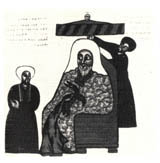Classic DACB Collection
All articles created or submitted in the first twenty years of the project, from 1995 to 2015.Takla-Haymanot (C)

Takla-Haymanot, Orthodox leader of renewal and mission. Takla-Haymanot was born in Silalish, Zorare (today the Bulga district of southern Ethiopia), into an ancient Orthodox clerical family whose roots in the town of Shawa extended back for ten generations. He is thought to have received his first religious instruction from his father, who was a priest. While still a young boy, and at a time when the Christian community in Shawa was a beleaguered, demoralized, and dwindling minority, he was ordained as a deacon by Egyptian Bishop Qerilos. As a young priest, Takla-Haymanot does not appear to have evinced any peculiar genius that might explain his profound influence in later years. His nine-year association with the Dabra Hayq monastery of Iyasus-Mo’a (begun when he was already well over 30 years of age) seems to have created little sensation, but it did lay the foundation for his subsequent monastic and evangelistic influence. As a middle-aged monk, he relocated to his mentor’s old monastic school at Dabra Damo in Tigre Province. Here he began to attract a substantial following of young men–including Ar’ayana-Saggahu, Madhanina-Egzi, and Bartalomewos–whose personal accomplishments would ensure their mentor enduring distinction in Ethiopian church history.
After playing a sustained and key role in the revival of monasticism in Tigre, the now venerable Takla-Haymanot returned to his place of origin in Shawa as emissary of a revitalized church. His success in transmitting the spirit of revival to Shawan Christian commmunities marks the apogee of his influence. While it is likely that he itinerated as a preacher, his enduring legacy was the establishment of a permanent center of Christian learning and monasticism at Dabra Asbo (today known as Dabra Libanos, Ethiopia’s most important monastery), which became an agent for the conversion of large segments of the pagan populations of Shawa, Damot, and Gojjam, reversing several centuries of relentless Muslim expansion in the region. It was here that Takla-Haymanot spent the three final and most fruitful decades of his life. Virtually all the church leaders and communities that emerged during this period of Christian resurgence in the districts of Katata and Grarya, as well as throughout the Shawan plateau, traced their origins either directly of indirectly to Takla-Haymanot’s Dabra Asbo community, thus ensuring the success of the subsequent efforts of King Amda-Siyon (1314-1344) to consolidate and expand Ethiopia as a Christian empire.
Jonathan J. Bonk
Bibliography
English sources are rather sketchy, at times unreliable, and somewhat difficult to access. Among the most useful are E. A. Wallis Budge, tr., The Life of Takla-Haymanot in the Version of Dabra Libanos, and the Book of the Riches of Kings (1906) and The Book of the Saints of the Ethiopian Church: A Translation of the Ethiopic Synaxarium, Made from the Manuscripts Oriental 660 and 661 in the British Museum (1928). More critical sources of information include G. W. B. Huntingford, “The Lives of Saint Takla Haymanot,” in Journal of Ethiopian Studies 4 (July 1966): 35-40, and Taddesse Tamrat, Church and State in Ethiopia, 1270-1527 (1972).
This article is reproduced, with permission, from the Biographical Dictionary of Christian Missions, copyright © 1998 by Gerald H. Anderson. All rights reserved.



